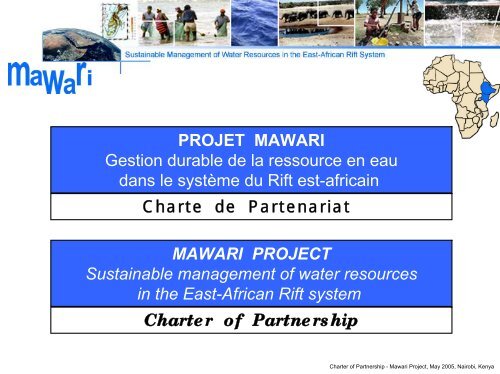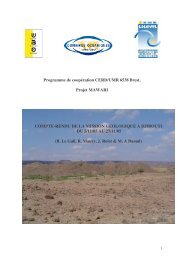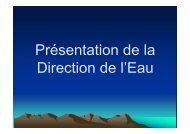projet mawari - MaWaRi.net
projet mawari - MaWaRi.net
projet mawari - MaWaRi.net
You also want an ePaper? Increase the reach of your titles
YUMPU automatically turns print PDFs into web optimized ePapers that Google loves.
PROJET MAWARIGestion durable de la ressource en eaudans le système du Rift est-africainCharte de PartenariatMAWARI PROJECTSustainable management of water resourcesin the East-African Rift systemCharter of PartnershipCharter of Partnership - Mawari Project, May 2005, Nairobi, Kenya
PROJET MAWARICharte de PartenariatMAWARI PROJECTCharter of Partnership1. PréambuleLe <strong>projet</strong> MAWARI se propose de faireavancer les connaissances scientifiques ducycle de l'eau de la région du Rift Est-africain.Le <strong>projet</strong> s'adresse aux universités et institutsspécialisés de trois pays qui travailleront encommun sur les thèmes fondamentaux desproblématiques régionales de l'eau.Ce <strong>projet</strong> fait suite à l'atelier qui s'est tenu àAddis Abeba du 26 au 29 novembre 2001 [1],au cours duquel le principe de ce <strong>projet</strong> a étéretenu, de même que les axes de recherche.1. IntroductionThe MAWARI project purpose is to boost thescientific knowledge of water cycle in the East-African Rift region.Universities and dedicated institutes of threecountries shall work jointly on the fundamentaltopics of the water-related regional issues.This project comes after the workshop held inAddis Ababa on November 26-29, 2001[1],during which the principle as well as theresearch orientation of the present projectwere adopted.[1] Regional workshop on research for sustainable water resources in East African Rift Valley,November 26-29, 2001, Addis Abeba.Charter of Partnership - Mawari Project, May 2005, Nairobi, Kenya
CPT Sean McWilliams on patrol in Baghdadabout four blocks from where an improvisedexplosive device (IED) wouldlater strike this same unarmored Humvee.that you are not indispensable; a new leader has assumedyour duties. Realizing that the mission continues without youtakes awhile to get your head around. Making things worse,there was a perceived stigma associated with rear detachment.The other wounded Soldiers and I felt like, “I am not adrug user, criminal, problem maker or newbie replacement.Why, then, am I being lumped into the same category?”Eventually, my time in purgatory ended. Unlike a lot ofothers, I got to rejoin my unit. The others stayed and waitedfor the unit to return. When I saw these Soldiers again, theyhad a number of complaints about how they were treated.This phase creates some additional challenges for thewounded Soldier. As this was a busy time for rear detachments,the wounded leaders were often assigned dutiesthat prevented them from being part of the reintegration.Arms-room inventories, convoy movement and other preparationsoften drew heavily from the pool of available,wounded leaders. They told me that although they felt beingbusy was good for them, they felt insulated from the reintegrationprocess. A number of Soldiers told me that they felttheir contributions during the deployment were not beingpublicly recognized. It did not help that rear detachmentSoldiers were in BDUs [battle dress uniforms] and returningsoldiers were in DCUs [desert camouflage uniforms].On my unit’s second deployment, we had a higher numberof casualties, and the entire brigade made an effort to incorporatethem into welcome-home or recognition ceremonies.We collectively were aware that the wounded Soldier hadstrong feelings of loyalty to the returning unit and wanted tobe part of the team again. One technique we found successfulwas a large ceremony after block leave. The brigade conducteda follow-on ceremony where we brought a number ofwounded soldiers to participate. This was vital to recognizingtheir accomplishments and reintegrating the “team.”One effect of my experience was a kind of empathy forSoldiers who by virtue of their injuries were moved out of aleadership position. I went out of my way to ensure thatwounded leaders were not at a disadvantage.One challenge I observedwas the reintegration of wounded leadersinto their old positions. Many returningleaders found it difficult to understandthat a junior leader hadstepped up to fill their position. TheSoldiers had grown accustomed to relyingon the junior leader to make decisions,so the reintegration of the seniorleader took a little time. Subtle secondguessingof the returning leader wasunintentional, yet it jeopardized theplatoon’s coherence. In a couple ofcases, I saw this create some resentment,but most platoons were able towork through this and reintegrate as a team.In more concrete terms, my experience made me emphasizethe reality of combat in our training. As an HHCcommander, I could partially influence how we conductedCPT Sean McWilliams waits for his flight home in theevacuation holding area at Ramstein Air Force Basein Germany, in October 2003. This photo was takennearly two weeks after the attack that wounded him.February 2008 ■ ARMY 53
PROJET MAWARICharte de PartenariatMAWARI PROJECTCharter of Partnership3. Durée du <strong>projet</strong>Ce <strong>projet</strong> durera quatre années à compter denovembre 2004.4. Objectifs de la charte de partenariatLa présente charte a pour objectif de donnerun cadre aux activités de recherche du <strong>projet</strong>.Elle organise les relations entre les diverspartenaires du <strong>projet</strong>.5. FinancementLa Coopération française contribue aufinancement de l'ensemble du <strong>projet</strong>.3. Duration of the projectThe project is scheduled to last four years,beginning in November 2004.4. Objectives of the partnership charterThe objectives of this charter are to establishthe rules for the organisation of the researchactivities during the project and therelationships between all partners.5. Project funding and budgetThe French Co-operation contributes to thefinancial support of the whole project.Charter of Partnership - Mawari Project, May 2005, Nairobi, Kenya
PROJET MAWARICharte de PartenariatMAWARI PROJECTCharter of Partnership6. Pays participantsQuatre pays participent à ce <strong>projet</strong> :– Djibouti–Ethiopie– France– Kenya.6. Involved countriesFour countries only are involved in this project:– Djibouti–Ethiopia– France– Kenya.Charter of Partnership - Mawari Project, May 2005, Nairobi, Kenya
PROJET MAWARICharte de PartenariatMAWARI PROJECTCharter of Partnership7. CoordinationL'animation et la coordination sont assuréespar le Centre International pour la Formatio<strong>net</strong> les Echanges en Géosciences (CIFEG) quirend compte à la Coopération française et auxpays participants du déroulement des activitéset reste à l'écoute des différents participants.7. Co-ordinationAnimation and co-ordination are ensured bythe International Centre for Training andExchanges in the Geosciences (CIFEG),which will report to the decision-makingorgans, the French Co-operation andparticipating countries, and will remain the linkbetween the project partners.Charter of Partnership - Mawari Project, May 2005, Nairobi, Kenya
PROJET MAWARICharte de PartenariatMAWARI PROJECTCharter of Partnership8. Centres de rechercheIl s'agit des organismes suivants :– l'Université d'Addis Ababa : Département deGéologie et Géophysique ;– l'Ethiopian Science and TechnologyCommission (ESTC), qui joue un rôle decoordination de la recherche, notamment enmatière de coopération internationale ;– le CERD de Djibouti ;– l'Université de Nairobi : Département deGéologie.D'autres organismes peuvent rejoindre cegroupe. Des partenariats seront organisésavec des établissements de recherchefrançais.8. Research centresThe participating research institutions are:– Addis Ababa University : Department ofGeology and Geophysics;– the Ethiopian Science and TechnologyCommission (ESTC) which plays a coordinationpart in the research domain,particularly in international co-operationissues;– the CERD : Centre d'Etudes et deRecherches de Djibouti;– Nairobi University : Department of Geology.Other institutions may take part to the project.A partnership will be organised with Frenchresearch institutes.Charter of Partnership - Mawari Project, May 2005, Nairobi, Kenya
PROJET MAWARICharte de PartenariatMAWARI PROJECTCharter of Partnership9. Activités de rechercheLes activités de recherche sont destinées àaméliorer les connaissances sur le cycle del'eau dans le Rift est-africain. Elles sontconduites en partenariat entre les acteurs du<strong>projet</strong> ; priorité sera donnée aux programmesassociant deux pays.Les programmes de recherche sont évaluéspar le Comité Scientifique Consultatif (CSC) etapprouvés par le Comité de pilotage du <strong>projet</strong>.9. Research activitiesThe research purpose is to enlarge thescientific knowledge of water cycle in the East-African Rift region. The research activities areconducted in partnership between participatingcountries; priority will be given to the programsassociating two countries.Research programs are evaluated by theConsulta-tive Scientific Committee (CSC) andapproved by the Steering Committee.Charter of Partnership - Mawari Project, May 2005, Nairobi, Kenya
PROJET MAWARICharte de Partenariat10. Responsabilités et engagements desparties10.1. Le CIFEG devra :– assurer le secrétariat général bilingue français-anglaisdu <strong>projet</strong>.– organiser les réunions :- du Comité de Pilotage (CdP). Il en fait le compte-rendu.- du Comité Scientifique Consultatif (CSC). Il en fait le compterendu.– faciliter les relations entre les partenaires, en particulierpour la constitution des équipes ;– assurer la logistique du <strong>projet</strong> ; en particulier :- organiser les déplacements des chercheurs dans lesuniversités de la région et les laboratoires français ;- organiser les déplacements des participants aux ateliers,réunions de Comité de Pilotage, réunions du Comité ScientifiqueConsultatif ;- la mise en œuvre, l’organisation, la gestion des fonds et leversement des sommes dues aux différentes équipesscientifiques.– agir dans le cadre du contrat qui le lie au Ministèrefrançais des Affaires étrangères.MAWARI PROJECTCharter of Partnership10. Duties and responsibilities of theparties10.1. CIFEG will have to :– organise the bilingual (French-English) generalsecretariat of the project.– organise the meetings of:- the Steering Committee, and then report;- the Consultative Scientific Committee, and then report.– make relationship between partners easy, and morespecifically to help at the teams settling.– manage logistic aspects and specifically:- the travelling of searchers to the universities of the area andto French laboratories;- the travelling for the attendants to workshops, steeringcommittees and consultative scientific committees;- manage and transfer fundings toward the scien-tific teams.– act in the framework of the contract between CIFEG andthe French Ministry of foreign affairs.Charter of Partnership - Mawari Project, May 2005, Nairobi, Kenya
PROJET MAWARICharte de Partenariat10. Responsabilités et engagements desparties10.2. Les organismes de recherche devront :– désigner un correspondant ayant les pouvoirs dedécision relatifs au <strong>projet</strong> MAWARI dans son pays ;– proposer des <strong>projet</strong>s de recherche ;– accepter de travailler en partenariat avec les autresmembres du <strong>projet</strong> ;– favoriser les activités de recherche en incitant deschercheurs à participer au <strong>projet</strong> et en mettant deséquipements disponibles au service du <strong>projet</strong> ;– accepter de publier les résultats des travaux derecherche issus du <strong>projet</strong> ;– faciliter la mobilité des chercheurs ;MAWARI PROJECTCharter of Partnership10. Duties and responsibilities of theparties10.2. The scientific teams will have to:– appoint the national project co-ordinator acting on behalfof his country in the MAWARI project;– propose research programs;– accept to work jointly with other members of the project;– boost the research activities by encouraging searchersto join the project and by making facili-ties and equipmentavailable for the project;– accept to publish the research results achieved alongthe project;– make the mobility of his searchers easy;– faciliter l'accueil de chercheurs des organismespartenaires.– welcome the searchers of the partner countries.Charter of Partnership - Mawari Project, May 2005, Nairobi, Kenya
PROJET MAWARICharte de PartenariatMAWARI PROJECTCharter of Partnership11. Résultats attendusLes résultats attendus du <strong>projet</strong> sont despublications scientifiques, une monographiedes travaux réalisés et un site WEB avecserveur pour l'information et la documentation.En fin de <strong>projet</strong>, ce site WEB sera restitué auxpays.12. Autres documentsDes accords spécifiques seront passés entrele CIFEG et les partenaires du <strong>projet</strong> pourfaciliter les mouvements de chercheurs, lamise à disposition des bourses et la prise encharge des frais induits par les activités derecherche.11. Expected outputsExpected outputs of the project are scientificpapers, a monograph gathering all the resultsof the project, and a WEB site with a server forthe exchange of bibliography and information.The WEB site will be handed over to thecountries at the end of the project.12. Other documentsSpecific bilateral agreements will be settledbetween CIFEG and each partner to facilitatethe travelling of searchers, to state preciselythe financing procedures intended for researchprojects operating costs, grant attributions,travel expenses, etc.Charter of Partnership - Mawari Project, May 2005, Nairobi, Kenya
PROJET MAWARICharte de PartenariatMAWARI PROJECTCharter of Partnership13. Comité de pilotageLe comité de pilotage est composé de 8 (huit)membres.Chaque pays participant nomme deuxmembres : l'un représente le domainescientifique et l'autre le domaine administratifde l'eau.Le représentant de la coopération françaisepréside le comité et se fait assister d'unscientifique du domaine de l'eau.13. Steering committeeThe Steering Committee is composed of 8(eight) members.Two representatives come from each country.One will be chosen among the politicaldecision-makers involved in watermanagement; the second one will act for thescientific community.The chair person is the representative fromthe French Co-operation; he is assisted by arepresentative of the French scientificcommunity.Charter of Partnership - Mawari Project, May 2005, Nairobi, Kenya
PROJET MAWARICharte de PartenariatMAWARI PROJECTCharter of Partnership14. Comité Scientifique Consultatif (CSC)Le comité consultatif est constitué de 5 (cinq)personnalités du domaine des Sciences de laTerre.15. Suivi, évaluation et bilanLe suivi scientifique du <strong>projet</strong> est assuré par leCSC et l'ensemble du <strong>projet</strong> est piloté par leCdP.Une évaluation externe sera réalisée à miparcourset à la fin du <strong>projet</strong>.14. Consultative Scientific Committee(CSC)The Consultative Scientific Committee gathers5 (five) members representing theinternational geoscientific community.15. Monitoring, evaluation and reportingThe project is managed by the steeringcommittee and the Scientific ConsultativeCommittee makes the scientific assessment.An external evaluation will occur at mid-termand at the end of the project.Charter of Partnership - Mawari Project, May 2005, Nairobi, Kenya








